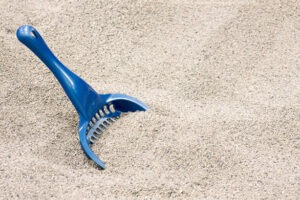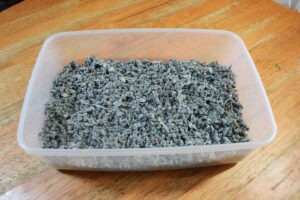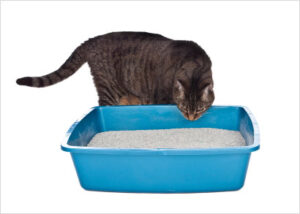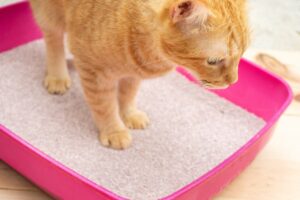Any responsible pet owner understands that the most important part of taking good care of your pets is managing their wastes. There are various ways one can use to manage cat litter; finding the best methods means that your cat’s health and surrounding remains safe all the time.
Here is what you should know on how to dispose of cat litter in the most eco-friendly manner.

Table of Contents
Impact of Cat Litter on the Environment
There are various types of cat litters, and each of them has different impacts on the environment; as a caring cat parent, you should consider choosing the right cat litter, which should not adversely affect the environment.

Clay cat litters
1. Productive process
Through strip mining, raw bentonite class is mined and pulled out of the earth’s surface one truckload at a time. To reach the clay needed for clay cat litters, mining companies must all the existing vegetation and topsoil, which are not good for our environment.
2. Environmental effects
- Erosion
- Deforestation
- Depletion of natural resources
- Loss of wildlife homes
- Getting the mining sediments washed to rivers and other water catchment areas.
This is highly dangerous to live creatures, water gets polluted, marine life gets endangered, and fish and aquatic vegetation. It is also feared to lead to high flooding chances as it destroys watersheds.
Clay cat litters are not biodegradable, which means even after the environment damaging mining process to obtain the clay that is not yet over.
Therefore, they have the same effect as plastic bags on the environment. Clay is known for its inability to decompose like all the other natural materials; this makes it a bad choice for your cat’s waste.
Crystal cat litter
There is no difference between clay cat litters and crystal cat litters; their fetching process is similar to the refined materials obtained from strip mining.
The only difference is; they use sand instead of bentonite clay; sodium silicate sand is the type of sand used to ensure that it absorbs moisture as much as possible.
Eco-friendly cat litter
However, there is an eco-friendly cat litter like the Tofukitty cat litter, safe for your cat and the surrounding before and after use.
Tofukitty is ecofriendly because it is biodegradable, renewable, made from non-toxic and natural materials, sustainable, and renewable since it is made from easy to recycle plant-based ingredients which will after some time end up in landfills due to its ability to decompose fast.
Why Should You Stop Using Plastic Bags to Dispose of Cat Litter?
Plastic bags are known for their non-biodegradable nature; they can survive for millions of years unsafe, threatening land creatures’ lives. For a cat parent who wants to achieve a cleaner environment and maintain their cats’ safety, you should not by any chance use plastic bags to dispose of the wastes. Instead of plastics, consider using the following methods:
• Use biodegradable bags
However, it might be difficult to find biodegradable bags to dispose of cat litters, but it is the most preferable and safer way to dispose of cat litters. There will be more heat required to break down the cat litter to less harmful substances; you will pay much attention to this; consider scooping off any moisture before transferring the cat litter to a biodegradable bag. Avoid wasting the litter in your home litter bin as there might not be relevant enzymes to break it down.

• Scoop and toss
It is the easiest way to dispose of cat litter; you will only need to scoop, toss it into a biodegradable litter bag and then later toss it into curbside garbage. Within thirty days, you will be in a position of changing the cat litter in the particular box, then use a newspaper to empty the litter and toss it into your trash bin.
• Dump the cat litter into a composite pile
It is the simplest; consider digging a composite pit where you can dump your cat litter and prevent them from destroying the environment. However, you should consider keeping the distance between where you grow foodstuffs is far from where the pit is dug.
General rules of disposing of cat litter
• Do not use liners to dispose of cat litter because they highly contribute to increased waste.
• Avoid using disposable scoops. Even though everyone would want to use disposable scoops to avoid contamination, it is important to use metal scoops to reduce wastes as one can easily clean them with vinegar and store them for future use.
• Avoid disposing of cat litters using plastic bags as this is not environmentally friendly; also, avoid all the possible situations that can make you use plastic bags.
Five Methods for Disposing of Used Cat Litter in the Greenest Way

Considering that cat waste cannot be dealt with wastewater and sewer treatment machines, it is important to find safer ways of disposing of them. Here are the five greenest was used to dispose of cat litter:
1. Use of biodegradable litter
Choose cat litters made from natural products that can easily compose over time; look for materials such as grass seed, sawdust, wheat, corn, compressed paper, among other natural materials. Most of the biodegradable cat litter is made from plant-based materials, making them more expensive than the other cat litters. Avoid using cat litters with silica dust or clay as this is harmful to the cat’s health and humans and the environment.
2. Dispose of cat litter in biodegradable bags
It is among the simplest ways to dispose of cat litter; you will only need to scoop, toss and dispose of a biodegradable bag then later trash them. Consider finding biodegradable bags specifically designed for disposing of cat litter; the bags have been designed to composite quickly and therefore can give you the best results. Ensure you pick bags that take very little time to break down the cat litter into less harmful substances before you trash them.
3. Make homemade cat litter with newspapers.
Making homemade cat litter is the most cost-effective way you can use to dispose of cat litter; you only need several newspaper pieces; however, their preparation requires more effort and time. With the correct procedures, you will develop a fully degradable alternative to dispose of cat litter as it can manage the cat waste’s odor effectively without any leakages.
4. Consider compositing your cat litter.
This is another greenways of disposing of cat litter, but it needs efforts, especially if you do not have a garden or a composite pit. If you have none of those, you will be required to dig one away from where you grow your vegetables or get a composite heap. Ensure that you regularly turn your composite heap to ensure that all the cat litter and other materials are broken down effectively.
5. Use the litter champ system to dispose of cat litter.
A litter champ system is eco-friendly and economically friendly. It is equipped with features that ensure the environment is safe and remains green at all costs; it contains continuous biodegradable liners meant to stay in place for up to three months while holding up to four gallons of waste. The liners can easily biodegrade after some time when put in a landfill. They are completely non-toxic, ozone friendly, and highly recyclable; therefore, there will be reduced wastes as you can always recycle them, saving on your costs.
Cat Litter Safety Precautions

The main important part of properly taking care of your cat is to be aware of and understand any dangers available in their surroundings, including cat litter safety brought about by clumping agents and additives. Here is how you can easily choose a safer cat litter to ensure that your cat is always in good condition.
• Avoid cat litters with sodium bentonite because this natural clay is claimed to swell for up to fifteen times the normal size when exposed to moisture. This is not safe for the cats as they might easily ingest it when they lick their paws or fur. Cats are known to be curious, and they can be tempted to taste the clay when they first get introduced to this, which is not safe to their gastrointestinal tract as it can easily turn into gummy-like structures that harden when ingested.
• Litter dust is not good for both cats and human health; when ingested, it can easily cause serious respiratory problems due to the presence of crystalline silica.
• Clay litter is not biodegradable; therefore, it poses a serious effect on the environment, and therefore one should avoid disposing of the cat litter carelessly.
Why Not Composting Cat Litter?

Compositing cat litter is not a good idea or trying to dispose of the cat litter in your garden because it is likely to contain harmful bacteria found in the cat’s waste. The bacteria is harmful to both humans and other living animals.
Moreover, the clay used to make cat litter does not decompose easily like other materials put in a composite heap, and some are believed to take very long periods to decompose and break down. You are planning to composite cat litter, making sure you do not use the final product to grow edible foodstuffs.
Two Ways of Composting Your Used Cat Litter Properly.

The following ways should help you understand how to composite used cat litter properly easily:
1. Cold composting method
You will need only compositing bins to make this a success; follow the following steps to understand what is expected of you:
• Use brown materials to cover the bottom of your smaller bins and garden soil to cover the larger composite bins, followed by a brown material layer, then cardboard or dust.
• Transfer the used cat litter to the larger bins, then add fresh layers of brown materials together with the soil.
• Aerate the composite to speed up the larger bins decomposition process; achieve this y stirring at least two times a week.
Ensure that the composite does not produce a foul smell, and it stays moist but not wet; when you find it too dry, consider adding some water and if it is too wet, add several brown materials.
2. Hot pile compositing method
To make this a success consider reading through the following steps:
• Choose the cat litter you want to composite from the clay-based, crystalline, or sand-based cat litter. The natural cat litters are the easiest to composite as they do not require too much attention.
• Add sawdust, leaves, and soil layers to the cat litter in the composite bin, ensure you cover them well, and always be observant to ensure no odor comes from the composite.
• For at least six months, always turn and aerate your composite to make sure every harmful component is broken down and the ammonia made useful.
FAQ:
1. Can you dump cat litter outside?
Do not dump your cat litter outside; it is important to consider burning them in the cases where one stays upcountry. For clay litters, consider composting them but avoid as much as possible dumping them outside carelessly.
2. Can you flush cat litter down a toilet?
Although this can be seen as the best idea, it is not advisable to flush either cat litter or feces down the toilet. Since it can easily make your pipes clog or even cause serious damages to the septic system, even if you do serious separation of feces and cat litter, you should not still consider flushing a good idea.
3. Can you put cat litter in the green bin?
Yes, you can put your cat litter in green for compositing purposes; this is done after rolling the cat litter in compostable litter bags. But if you think of something else apart from compositing the litter, do not put it in a green bin.
4. Is cat poop toxic to plants?
Cat poop is highly toxic to plants because feces and urine contain harmful microbes and parasites that are not sanitary for vegetable growth. Therefore, this explains more about the reasons why you should not dump cat litter in gardens where you grow edible stuff.
5. Are lighter cat litters save money on garbage disposal fees?
This happens where one pays garbage disposal fees depending on weight pounds, where the weight is heavier than the charges are likely to be low, and when it is heavy, you will be charged higher than normal.
Conclusion
It is crucial to always put into consideration the environmental impacts that accompany different cat litter disposal methods. With each way having its positive and negative side, every cat parent should go for what ensures that their cat’s health is safe. Hygiene and other factors determine the household’s growth and general health, especially when you have pets around.
